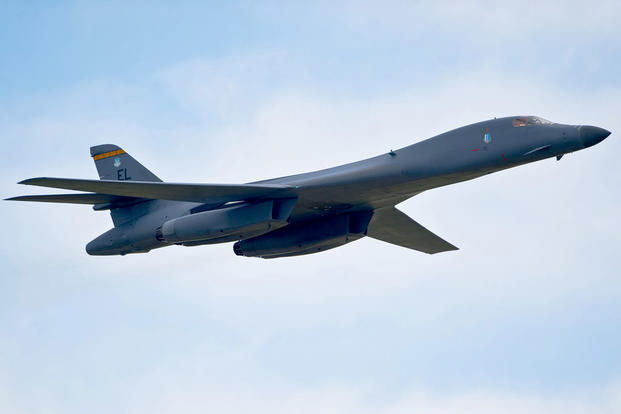The U.S. is preparing to send two B-1B Lancer bombers to South Korea in a show of force and commitment to Seoul's defense following the latest underground nuclear test by North Korea, South Korea's Yonhap news agency reported.
The U.S. had planned to have the bombers fly over Osan Air Base, about 50 miles southeast of Seoul, on Monday, but the overflight was postponed because of Typhoon Lionrock in the region, Yonhap reported.
The overflight of the B-1Bs, flanked by South Korean and U.S. fighter jets, is now scheduled for Tuesday, Yonhap reported, citing a spokesman for U.S. Forces Korea.
The bomber flights are a response to North Korea's underground nuclear test last Friday, which Pyongyang said was aimed at perfecting a miniaturized nuclear warhead capable of being fitted on a long-range missile.
The nuclear test was the fifth conducted by North Korea. Yonhap, citing government sources, said plans appear to be underway to conduct a sixth test in defiance of the international community, even as North Korea reportedly is seeking aid to cope with deadly torrential rains and flooding caused by the typhoon.
The Korean Central News Agency, an official North Korean outlet, said, "The country's manpower and material and technical potentials are now concentrated on the flood damage rehabilitation."
The ruling party urged citizens to "achieve the miraculous victory of converting misfortune into favorable conditions."
North Korean media also said the focus of a 200-day "loyalty campaign" already underway to mobilize the nation behind leader Kim Jong Un in a mandatory show of devotion had been switched to a call for all citizens to support the recovery effort, The Associated Press reported.
According to a United Nations report issued by the Office for the Coordination of Humanitarian Affairs, the floods displaced tens of thousands of people and destroyed homes, buildings and critical infrastructure.
The U.N. report said the North Korean government has confirmed that 133 people were killed, another 395 were missing, and 140,000 were in need of urgent assistance.
It said more than 35,500 houses, schools and public buildings were damaged, with 69 percent of those completely destroyed, and there was widespread inundation of farmland.
"It's not unheard of, but it's rare for the North Korean government to make an open and public call for assistance," Bradley Williams, an international relations professor at City University in Hong Kong, told CNN.
Following the North's nuclear test last week, President Obama issued a statement condemning it as "a grave threat to regional security and to international peace and stability. North Korea stands out as the only country to have tested nuclear weapons this century."
Obama said the U.S. would seek to defend its regional allies "through our deployment of a Terminal High Altitude Area Defense [THAAD] battery to the [Republic of Korea], and the commitment to provide extended deterrence, guaranteed by the full spectrum of U.S. defense capabilities."
Defense Secretary Ashton Carter said that the defensive capabilities would include the U.S. "nuclear umbrella" as a last resort. In remarks last Friday after the underground nuke test, Carter said he had told his South Korean counterpart that the U.S. was prepared to use "all aspects of our extended deterrent capabilities, including conventional capabilities, missile defense and the nuclear umbrella."
At the Pentagon last Friday, Navy Capt. Jeff Davis, a spokesman, said that negotiations were continuing with South Korea on the placement of the THAAD system, but "it could be moved in quickly" in an emergency.
-- Richard Sisk can be reached at Richard.Sisk@Military.com.
Related Video:
Bullet Points: B-1B Lancer



























